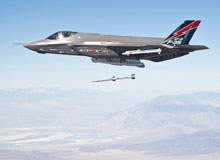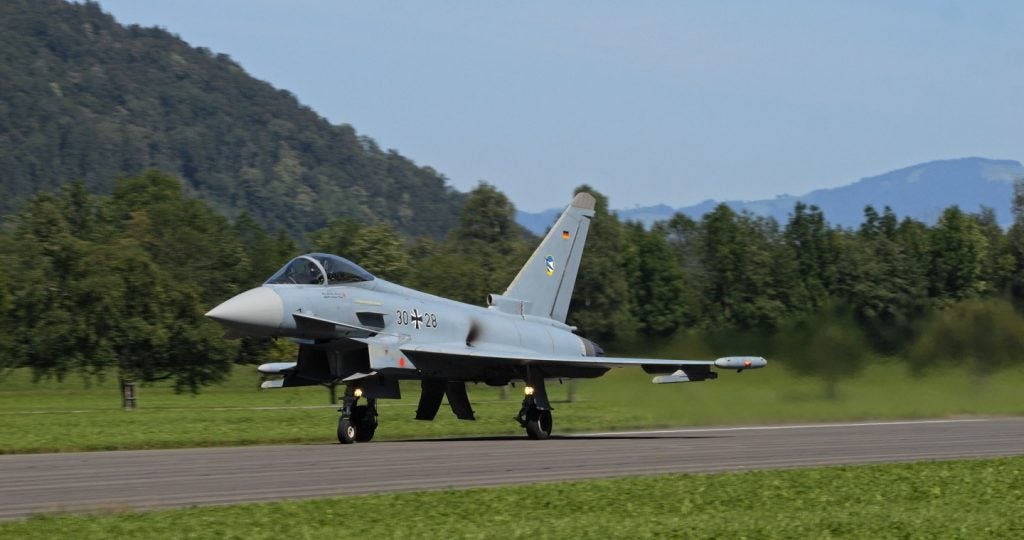
Top 10 Features of the World’s Most Advanced Fighter Aircraft
Lockheed Martin F-35 Lightning II
F-35 Lightning II is the only international fifth-generation multirole fighter in the world. Stealth features, along with an integrated sensor package and modern weaponry, is intended to provide the F-35 with a tactical edge over all other fighter aircraft.
The single-seat fighter is armed with a range of weapon systems such as Sidewinder and AIM120 AMRAAMs, as well as Joint Direct Attack Munitions (JDAMs).
Lockheed Martin is the prime contractor of the F-35 while its major partners include Northrop Grumman, BAE Systems, and Pratt & Whitney.
The F-35 completed its maiden flight in December 2006. The three F-35 variants, including the conventional take-off and landing (CTOL), short take-off / vertical landing (STOVL) and carrier variant (CV), will replace the A-10 and F-16 of the US Air Force, the F/A-18 of the US Navy, the F/A-18 and AV-8B Harrier of the US Marine Corps and various fighters of other allied nations.
Related suppliers: Landing Aids, Guidance and Lighting
Lockheed Martin / Boeing F-22 Raptor
The F-22 Raptor developed by Lockheed Martin and Boeing is a single-seat, twin-engine fifth-generation advanced tactical fighter. The stealth, integrated avionics and performance potentially makes the F-22 the most capable air-to-air combat aircraft in the world.
Inducted by the US Air Force (USAF) as an air-superiority fighter, the F-22 evolved into multi-mission fighter aircraft.
How well do you really know your competitors?
Access the most comprehensive Company Profiles on the market, powered by GlobalData. Save hours of research. Gain competitive edge.

Thank you!
Your download email will arrive shortly
Not ready to buy yet? Download a free sample
We are confident about the unique quality of our Company Profiles. However, we want you to make the most beneficial decision for your business, so we offer a free sample that you can download by submitting the below form
By GlobalDataThe Raptor made its first flight in September 1997. The first production F-22 was delivered to Nellis Air Force Base in January 2003. The aircraft formally entered USAF’s service in December 2005.
The F-22 Raptor employs sophisticated air-to-air and air-to-ground missiles. The emerging technologies integrated aboard the F-22 make it capable for a wide array of missions, including surveillance, reconnaissance, attack, electronic warfare, and signals intelligence.
Chengdu J-20
Chengdu J-20 is a fifth-generation, single-seat, twin-engine stealth fighter jet manufactured by Chengdu Aircraft Industry Group (CAIG) to perform aerial combat operations for the People’s Liberation Army Air Force (PLAAF).
The aircraft has eight hardpoints and an internal weapons bay that can hold a mix of beyond-visual-range air-to-air and short-range missiles, including long-range PL-12C/D and PL-21 air-to-air missiles. It is also armed with air-to-surface missiles, laser-guided bombs and anti-radiation missiles.
The J-20 features blended fuselage, canard delta configuration, low jet engine intakes, and an advanced fly-by-wire (FBW) system.
The aircraft made its first flight in January 2011 and was officially unveiled in 2016. It entered the PLAAF’s service as an air-superiority fighter in March 2017.
Sukhoi Su-57
The Su-57 is a fifth-generation, single-seat, twin-engine, multi-role fighter aircraft manufactured by Sukhoi, a subsidiary of United Aircraft Corporation. It was formerly known as PAK FA and T-50.
The aircraft is designed to perform air superiority and attack missions primarily of the Russian Air Force and the Russian Navy. It can defend all types of ground, air and surface targets of the enemy and monitor the airspace at longer ranges.
With a combat weight of 10t, the aircraft can carry short-range air-to-air missiles, air-to-surface missiles such as X-31, X-35, X-38, X-58, X-59, short and medium-range guided and unguided weapons, and aerial bombs in 250kg, 500kg, and 1,500kg classes.
The aircraft made its first flight in January 2010 and is currently in the final flight testing phase. It is expected to be introduced by the Russian Air Force in 2019, replacing the existing fleet of Su-27 fourth-generation fighter.
Eurofighter Typhoon
Eurofighter Typhoon is a relatively new generation multirole fighter aircraft, typically considered to be bridging the gap between fourth and fifth generation platforms. It is a delta wing aircraft integrating modern avionics and sensors, Defensive Aids Sub System (DASS) and distinct weapons, such as Mauser BK-27 27mm cannon, air-to-air, air-to-surface and anti-ship missiles and precision-guided munitions.
Eurofighter Typhoon’s development is Europe’s largest multinational military collaborative effort managed by the Nato Eurofighter and Tornado Management Agency (NETMA), which is also the prime customer.
The programme delivers cutting-edge technologies for the European defence industry.
Eurofighter Typhoon made its combat début in 2011 for reconnaissance and ground strike missions in Libya by the Royal Air Force (RAF) and the Italian Air Force. The aircraft is being continuously modernised by its European and Middle East operators, to include AESA radar capabilities and additional emergent munitions.
Related suppliers: Electronics, Subsystems and Components
Sukhoi Su-35
Sukhoi Su-35 is a heavily-modified version of the Su-27 fighter. The Su-35 is a 4+ generation aircraft employing some technologies of the fifth-generation, providing a distinct advantage when compared to current fourth generation platforms available or in development.
The first Su-35 prototype was built at Komsomolsk-na-Amure Aviation Production Association in 2007. The maiden flight of Su-35 was concluded in February 2008.
The Su-35 is capable of deploying long and short-range air-to-air missiles, and precision and unguided air-to-ground munitions such as missiles, bombs and rockets. The 14 hardpoints of the aircraft can carry a maximum weapon payload of 8t.
Boeing F/A-18E/F Super Hornet
F/A-18E/F Super Hornet is a combat-proven strike fighter offering next-generation multirole strike fighter capabilities. It is a larger and improved redesign of the F/A-18C/D Hornet. The Super Hornet is in service with the US Navy and the Royal Australian Air Force (RAAF).
The US Navy inducted the aircraft into service in 1999 for replacing its Grumman F-14 Tomcat. The F/A-18F Super Hornet (two-seat version) entered service with the RAAF in 2010.
Combat capabilities of the fighter jet were proved during Operation Iraqi Freedom, Operation Enduring Freedom, Operation Southern Watch and War in Afghanistan.
The Super Hornet’s suite of integrated and networked systems provides enhanced interoperability and total force support for the combatant commander and for troops on the ground. The 11 weapon stations on the aircraft can hold a mix of air-to-air and air-to-ground ordnance, as well as a variety of smart weapons, including laser-guided bombs.
Related suppliers: Fire Control, Surveillance and Targeting
Dassault Rafale
Described as an ‘omnirole’ fighter by its manufacturer Dassault Aviation, Rafale is a twin-engine, multirole fighter aircraft that is capable of performing air sovereignty, deep strike, reconnaissance and airborne nuclear deterrent duties.
The multirole fighter is operated by the French Air Force and Navy. The aircraft has seen success in the export market, with the United Arab Emirates and Indian either soon to operate or operating the aircraft, among others such as Greece.
It can carry a 30mm cannon, air-to-air and air-to-surface missiles, nuclear and anti-ship missiles, as well as a range of laser-guided bombs and ground-attack munitions.
The maiden combat deployment of the Rafale fighter was in 2002 during the Operation Enduring Freedom. The aircraft has been used in a number of combat missions in Afghanistan, Libya and Mali (Operation Serval).
The aircraft is available in three variants, namely RAFALE C single-seat, RAFALE M carrier-based single-seat and RAFALE B twin-seat version.
Boeing F-15E Strike Eagle
The F-15E Strike Eagle is a superior next-generation multirole strike fighter. Developed as a derivative of earlier F-15A/D aircraft, the F-15E is the backbone of the US Air Force (USAF) today.
The F-15E can carry up to 23,000lb of payload, including the Joint Direct Attack Munition (JDAM), AGM-130 Standoff Weapon System, the AIM-120 Advanced Medium Range Air-to-Air Missile (AMRAAM), AIM-9X Sidewinder and a variety of bombs. It can fly at more than twice the speed of sound.
The state-of-the-art avionics systems provide the Strike Eagle with the ability to conduct air-to-air and air-to-surface missions in all weather conditions during the day or night.
The F-15Es were extensively deployed by the USAF in Operations Desert Shield and Desert Storm as well as Operations Southern Watch and Northern Watch. Other notable combat deployments include Operation Deny Flight, Operation Enduring Freedom, Operation Iraqi Freedom and Operation Odyssey Dawn.
Su-30MKI (Flanker-H)
Su-30MKI (Flanker-H) is a two-seat, long-range multirole fighter in service with the Indian Air Force (IAF). Designed by Russia’s Sukhoi, the Su-30MKI is assembled under licence by India’s Hindustan Aeronautics Limited (HAL).
The first Russian-built Su-30MKI variant entered into service with the IAF in 2002, while the first India-made aircraft was introduced into the IAF in 2004. The Su-30MKI features multinational avionics and subsystems as the components are supplied by 14 manufacturers from six nations.
The Su-30MKI can carry a range of air-to-air and air-to-surface missiles, including the Brahmos supersonic cruise missiles. The armament also includes a 30mm GSh-30-1 gun and a variety of bombs.
Related content
Improving air defence capabilities through computer simulations
From the latest-generation flight simulators to the world of gaming consoles, simulations are used in every walk of life.
An integrated vision: Nato’s Air Command and Control System
Nato is on the brink of fielding an integrated air command and control system in four member countries.


.gif)




